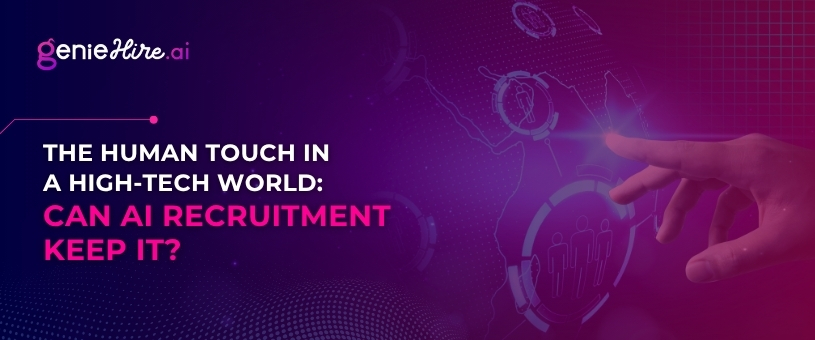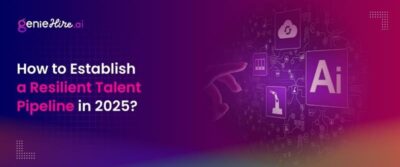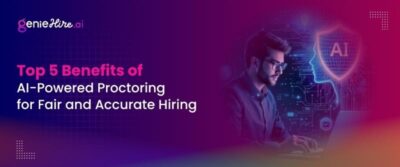Hiring the right people has never been simple. Resumes tell part of the story, interviews reveal another, and sometimes a gut feeling seals the deal. However, now there’s a new player in the hiring process: AI recruitment, bringing speed, precision, and automation into the mix.
The promise is tempting: faster hiring, better candidate matches, and reduced manual work. But here’s the big question: can a recruitment process powered by algorithms still keep the personal connection that makes hiring more than just filling a vacancy?
Understanding AI Recruitment
AI recruitment refers to the use of artificial intelligence to automate and streamline various aspects of the hiring process. Think of it as a smart assistant that never gets tired, can read thousands of resumes in seconds, and can make recommendations based on data.
These systems can:
- Scan and rank resumes based on job requirements
- Can match candidates to roles by aligning their skills, experience, and growth potential.
- Conduct AI-driven interviews and analyze responses
- Predict job performance using past trends and metrics
- Provide insights into the talent pool
According to Grand View Research, the global AI recruitment market is projected to grow steadily at a 6.5% CAGR from 2024 to 2030, mainly because businesses are looking for faster, more accurate, and cost-effective ways to hire.
Why Businesses Are Turning to AI in Hiring
Hiring is time-consuming. Traditional recruitment often involves manually going through hundreds of resumes, coordinating interviews, and shortlisting candidates, a process that can take weeks or even months.
AI changes this by cutting down the time spent on repetitive tasks. For example, instead of manually reading each resume, AI can scan them instantly, identify the most relevant ones, and flag potential top candidates.
It’s not just about saving time. AI can also detect patterns that recruiters might miss, like transferable skills from different industries or career progression trends that signal growth potential.
In competitive industries where top talent gets hired quickly, AI recruitment gives businesses the speed advantage they need.
The Human Element in Recruitment
Recruitment goes beyond simply matching skills to a job description; it’s fundamentally about understanding people. Why are they looking for a new role? What motivates them? How will they fit into the company’s culture?
These are the areas where human recruiters excel. They can pick up on subtle cues during conversations; enthusiasm in a candidate’s tone, curiosity in their questions, or hesitation about a role. These human insights can’t be fully replicated by an algorithm.
Without the human touch, recruitment risks becoming purely transactional. Candidates might feel like just another number in a database, which can harm the company’s brand and make top talent look elsewhere.
The Balancing Act: AI + Human Judgment
Successful hiring strategies are those that blend AI’s efficiency with human insight and judgment.
AI as the First Filter
AI tools are great at handling large volumes of applications. They can shortlist candidates who meet the essential qualifications, freeing recruiters from spending hours on the initial screening. As an example, AI can immediately screen out applicants who don’t have the required certifications or years of experience for a position.
Humans as the Final Decision-Makers
While AI can identify who ticks the technical boxes, it’s the recruiter who assesses whether a candidate’s personality, values, and work style align with the team. This is where human conversations, gut instincts, and cultural insights become crucial.
To put it simply, AI focuses on “who is qualified for the job,” leaving the decision of “who is the best fit for the job” to humans.
Building a Candidate-Centric AI Recruitment Process
It’s possible to use AI recruitment tools without losing personal touch if you design the process carefully.
Personalize Communication
Even if AI sends automated updates, add personal touches wherever possible. For example, you can customize rejection emails to thank candidates for their time and encourage them to consider future openings.
Use AI for Insights, Not Decisions
Treat AI’s recommendations as guidance, not final verdicts. Let recruiters review AI-shortlisted candidates to ensure no great fit slips through the cracks.
Keep Interviews Human-Led
Video interviews, skill assessments, and chatbots can help in the early stages, but always include a human-led interview before making a final decision. Candidates value the chance to connect with a real person who represents the company.
The Competitive Advantage of Human-AI Collaboration
The collaboration between AI and human recruiters can produce powerful results. AI speeds up the process and surfaces high-potential candidates, while humans bring empathy, context, and relationship-building into the mix.
This approach leads to:
- Faster hiring timelines
- Better-quality hires
- Higher retention rates
- Improved candidate satisfaction
For small and large businesses alike, this combination can make the difference between hiring to fill a vacancy and hiring to grow the company’s future.
Looking Ahead: The Future of Hiring
The future of recruitment is unlikely to be fully AI-driven or entirely human-led; it will be a hybrid. AI analysis will continue to handle time-consuming tasks like screening, scheduling, and assessment analysis, while humans will focus on decision-making and relationship management.
Moving forward, candidates will expect a blend of AI’s speed and convenience with the empathy and understanding that only human recruiters can provide.
Conclusion
AI recruitment is transforming how businesses hire, making processes faster, more consistent, and data-driven. But efficiency should not come at the cost of connection.
The real win lies in blending technology with the human touch. AI should handle the heavy lifting so recruiters can focus on building trust, understanding motivations, and finding the right fit, not just on paper, but in practice.
In a high-tech hiring world, the companies that master this balance will not only attract top talent but also keep them engaged for the long run.




